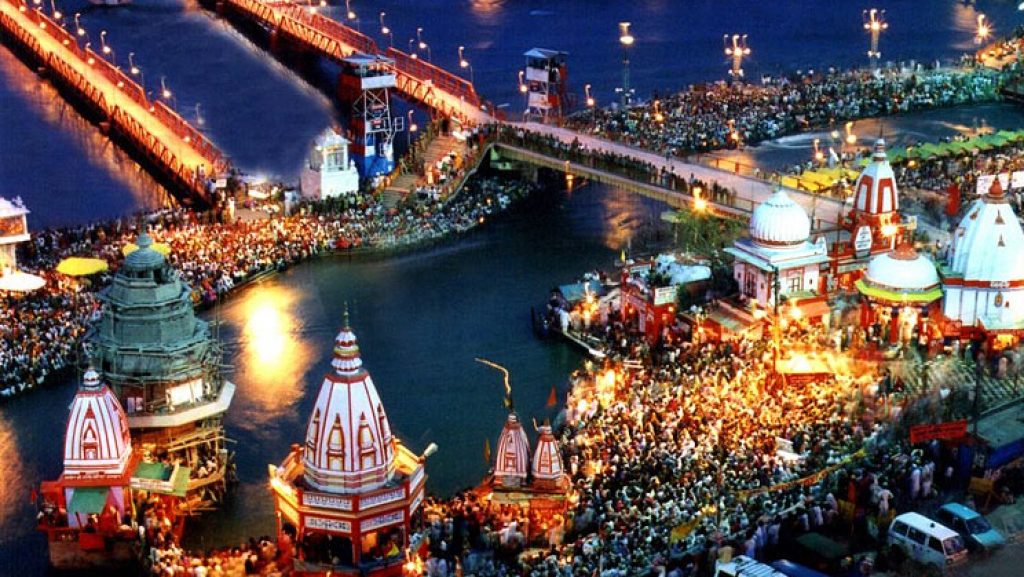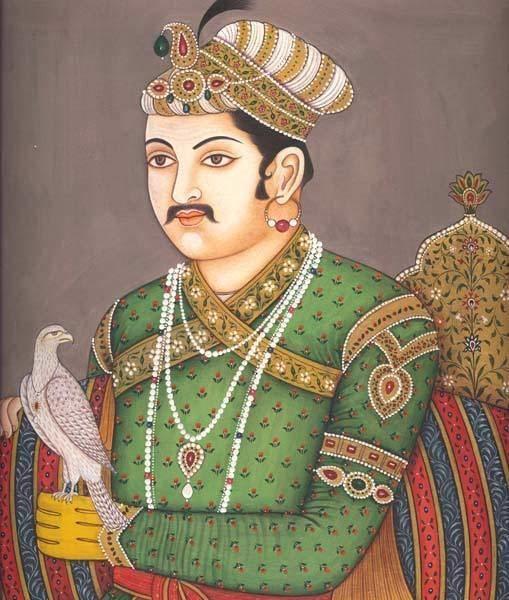
- Haridwar city that’s also known as Kumbh Nagri, Gateway of Hills, and the City of Bridges is an ancient city in Uttarakhand, India.
- It is situated on the bank of the Ganga river, at the foothills of the Shivalik ranges.
- Haridwar is an ancient city and an important Hindu pilgrimage city
Haridwar Uttarakhand (India): It is an ancient city, and an important Hindu pilgrimage city in Uttarakhand, India. The Holy River Ganges exits the Himalayan foothills and reaches the city to make Haridwar a perfect place of worship.
The most important of several sacred ghats (bathing steps), Har Ki Pauri hosts a nightly Ganga Aarti (river-worshipping ceremony) during which tiny flickering lamps are floated off the steps. Worshipers fill the town during major festivals including Baisakhi Mela, Kanwar Mela, and Kumb Mela( Celebrated every 12th year)

Haridwar city that’s also known as Kumbh Nagri, Gateway of Hills, and the City of Bridge. It is situated on the bank of the Ganga river, at the foothills of the Shivalik ranges. Haridwar is regarded as a holy place for Hindus, hosting important religious events and serving as a gateway to several prominent places of worship.
Kumbh Nagri
The most significant of the events is the Kumbha Mela, which is celebrated every 12 years in Haridwar. During the Haridwar Kumbh Mela, millions of pilgrims, devotees, and tourists congregate in Haridwar to perform ritualistic bathing on the banks of the river Ganges to wash away their sins to attain Moksha.
Haridwar along with Ujjain, Nashik, and Prayagraj (Allahabad) is one of four sites where drops of Amrit, the elixir of immortality, accidentally spilled over from the pitcher while being carried by the celestial bird Garuda during the Samudra Manthan.
Brahma Kund, the spot where the Amrit fell, is located at Har ki Pauri (footsteps of the Lord) and is considered to be the most sacred ghat of Haridwar.
It is also the primary centre of the “Kanwar” pilgrimage, in which millions of participants gather sacred water from the Ganga and carry it across hundreds of miles to dispense as offerings in Śhiva shrines.
It is additionally a passage for the Chota Char Dham (the four principal pilgrim destinations in Uttarakhand viz, Badrinath, Kedarnath, Gangotri, and Yamunotri), subsequently, Shaivaites (adherents of Lord Shiva) and Vaishnavites (devotees of Lord Vishnu) call this place Hardwar and Haridwar individually, relating to Har being Shiv and Hari being Vishnu.
Haridwar is famous for its Har Ki Pauri

Har Ki Pauri is a famous ghat on the banks of the Ganga in Haridwar. This revered place is the major landmark of the holy city of Haridwar.
“Har” means “God”, “Ki” means “of”, and “Pauri” means “steps”
Literally, “Har” means “God”, “Ki” means “of”, and “Pauri” means “steps”. Lord Vishnu is believed to have visited the Brahmakund in Har Ki Pauri in the Vedic times.
It is believed that it is a precise spot where the Ganges leaves the mountains and enters the plains.
Har Ki Pauri is also the area where thousands of pilgrims converge and the festivities commence during the Kumbha Mela, which takes place every twelve years, and the Ardh Kumbh Mela, which takes place every six years
The ghat is on the west bank of the Ganges canal through which the Ganges is diverted just to the north. Har Ki Pauri is also the area where thousands of pilgrims converge and the festivities commence during the Kumbha Mela, which takes place every twelve years, and the Ardh Kumbh Mela, which takes place every six years and the Punjabi festival of Vaisakhi, a harvest festival occurring every year in the month of April
Haridwar presents a kaleidoscope of Indian culture and development. In the sacred writings, it has been differently specified as Kapilsthan, Gangadwar, and Mayapuri.
The modern name of the town has two spellings: Haridwar and Hardwar. Each of these names has its own connotation.
Similarly, Hara could also mean “Lord Shiva”. Hence, Hardwar could stand for “Gateway to Lord Shiva“. Hardwar is also a typical place to start a pilgrim’s journey in order to reach Mount Kailash, Kedarnath, the northernmost Jyotirlinga, and one of the sites of the smaller Char Dham pilgrimage circuit – all important places for worship for Hindus.
In Sanskrit, the liturgical language of Hinduism, Hari means “Lord Vishnu“, while dwar means “gateway“. So, Haridwar translates to “The Gateway to Lord Vishnu“. It earns this name because it is typically the place where pilgrims start their journey to visit a prominent temple of Lord Vishnu – Badrinath.
According to legend, it was in Haridwar that Goddess Ganga descended when Lord Shiva released the mighty river from the locks of his hair. The River Ganga, after flowing for 253 kilometres (157 mi) from its source at Gaumukh at the edge of the Gangotri Glacier, enters the Gangetic Plain for the first time at Haridwar, which gave the city its ancient name, Gangadwára.
City is also an Industrial hub
Today, the city is developing beyond its religious importance, with the fast developing industrial estate of State Industrial Development Corporation of Uttarakhand (SIDCUL), and the close by township of Bharat Heavy Electricals Limited as well as its affiliated ancillaries.
In the scriptures, Haridwar has been variously mentioned as Kapilasthana, Gangadwara, and Mayapuri. It is also an entry point to the Char Dham (the four main centers of pilgrimage in Uttarakhand viz, Badrinath, Kedarnath, Gangotri, and Yamunotri), hence, Shaivaites (followers of Lord Shiva) and Vaishnavites (followers of Lord Vishnu) call this place Hardwar and Haridwar respectively, corresponding to Hara being Shiv and Hari being Vishnu.
In the Vanaparva of the Mahabharat, where sage Dhaumya tells Yudhishthira about the tirthas of India, Gangadwar, i.e., Haridwar and Kankhal, have been referred to, the text also mentions that Agastya Rishi did penance here, with the help of his wife, Lopamudra (the princess of Vidharba).
Sage Kapila is said to have an ashram here giving it, its ancient name, Kapila or Kapilasthana.
The legendary King, Bhagiratha, the great-grandson of the Suryavanshi King Sagar (an ancestor of Rama), is said to have brought the river Ganges down from heaven, through years of penance in Satya Yuga, for the salvation of 60,000 of his ancestors from the curse of the saint Kapila, a tradition continued by thousands of devout Hindus, who bring the ashes of their departed family members, in hope of their salvation. Lord Vishnu is said to have left his footprint on the stone that is set in the upper wall of Har Ki Pauri, where the Holy Ganges touches it at all times.
History of City
Haridwar came under the rule of the Maurya Empire (322–185 BCE), and later under the Kushan Empire (c. 1st–3rd centuries). Archaeological findings have proved that terra cotta culture dating between 1700 BCE and 1200 BCE existed in this region.
The first modern-era written evidence of Haridwar is found in the accounts of a Chinese traveler, Huan Tsang, who visited India in 629 AD. during the reign of King Harshavardhan (590–647) records Haridwar as ‘Mo-yu-lo’, the remains of which still exist at Mayapur, a little to the south of the modern town.
Among the ruins are a fort and three temples, decorated with broken stone sculptures, he also mentions the presence of a temple, north of Mo-yu-lo called ‘Gangadwara’, Gateway of the Ganges.
During his visit to Haridwar, the first Sikh Guru, Guru Nanak (1469–1539) bathed at ‘Kushawart Ghat’, wherein the famous, ‘watering the crops’ episode took place, his visit is today commemorated by a gurudwara (Gurudwara Nanakwara), according to two Sikh Janamsakhis, this visit took place on the Baisakhi day in 1504 AD, he later also visited Kankhal en route to Kotdwara in Garhwal.
Pandas of the Haridwar
Pandas of the Haridwar have been known to keep genealogy records of most of the Hindu population. Known as Vahis, these records are updated on each visit to the city and are a repository of vast family trees of the family in North India.
Mughal emperor Akbar and his relation with Haridwar
Ain-e-Akbari, written by Abul Fazal in the 16th century during the reign of Mughal Emperor Akbar, refers to it as Maya (Mayapur), known as Hardwar on the Ganges”, as seven sacred cities of Hindus.

It further mentions it is eighteen kos (each approx. 2 km) in length, and large numbers of pilgrims assemble on the 10th of Chaitra.
It also mentions that during his travels and also while at home, Mughal Emperor, Akbar drank water from the Ganges river, which he called ‘the water of immortality‘. Special people were stationed at Sorun and later Haridwar to dispatch water, in sealed jars, to wherever he was stationed
It is said that Raja Man Singh of Amber, laid the foundation of the present-day city of Haridwar and also renovated the ghats at Har Ki Pauri. After his death, his ashes are also said to have been immersed at Brahma Kund.
During the Mughal period, there was mint for Akbar’s copper coinage at Haridwar. It is said that Raja Man Singh of Amber, laid the foundation of the present-day city of Haridwar and also renovated the ghats at Har Ki Pauri. After his death, his ashes are also said to have been immersed at Brahma Kund.
An English traveler-Thomas Coryat visited the Haridwar during 159-1627

Thomas Coryat, an English traveler, visited the city in the reign of Emperor Jahangir (1596–1627). That mentions it as ‘Haridwara‘, the capital of Shiva.
Being one of the oldest living cities, Haridwar finds its mention in the ancient Hindu scriptures. As it weaves through the life and time stretching from the period of the Buddha to the more recent British advent.
Haridwar has a rich and ancient religious and cultural heritage.
It still has many old havelis and mansions bearing exquisite murals and intricate stonework.
Bhimgoda Dam
One of the two major dams on the river Ganges, the Bhimgoda, is situated here. Built-in the 1840s, it diverts the waters of the Ganges to the Upper Ganges Canal. Which also irrigated the surrounding lands.
Port City
Though this caused severe deterioration to the Ganges water flow. And is a major cause for the decay of the Ganges. As an inland waterway, which till the 18th century was used heavily by the ships of the East India Company. And a town as high up as Tehri was considered a port city. The headworks of the Ganges Canal system is located in Haridwar.
The Upper Ganges Canal was opened in 1854 after the work began in April 1842, prompted by the famine of 1837–38. The unique feature of the canal is the half-kilometer-long aqueduct over the Solani river at Roorkee, which raises the canal 25 m (82 ft) above the original river.
Municipality of the city
City’s Union Municipality was constituted in 1868, which included the then villages of Mayapur and Kankhal.
Haridwar was first connected with railways, via Laksar, through branch line in 1886, when the Awadh and Rohilakhand Railway line was extended through Roorkee to Saharanpur, this was later extended to Dehradun in 1900
Haridwar was first connected with railways, via Laksar, through branch line in 1886, when the Awadh and Rohilakhand Railway line was extended through Roorkee to Saharanpur, this was later extended to Dehradun in 1900.
In 1901, it had a population of 25,597 and was a part of the Roorkee tehsil, in Saharanpur district of the United Province, and remained so till the creation of Uttar Pradesh in 1947.
Haridwar has been an abode of the weary in body, mind, and spirit. It has also been a centre of attraction for learning various arts, science, and culture.
This City is home to the unique Gurukul

The city has a long-standing position as a great source of Ayurvedic medicines and herbal remedies and is home to the unique Gurukul (school of traditional education), including the Gurukul Kangri Vishwavidyalaya, which has a vast campus, and has been providing traditional education of its own kind, since 1902.
BHEL in Haridwar

The development of Haridwar took an upturn in the 1960s, with the setting up of a temple of modern civilisation. BHEL, a ‘Maharatna PSU’ in 1975, brought along not just its own township of BHEL, Ranipur, close to the existing Ranipur village, but also a set of ancillaries in the region.
The University of Roorkee – IIT Roorkee

The University of Roorkee, now IIT Roorkee, is one of the oldest and most prestigious institutes of learning in the fields of science and engineering.
The river Ganges flows in a series of channels separated from each other called aits, most of which are well wooded. Other minor seasonal streams are Ranipur Rao, Pathri Rao, Ravi Rao, Harnaui Rao, Begham Nadi, etc.
A large part of the district is forested, and Rajaji National Park is within the bounds of the district, making it an ideal destination for wildlife and adventure lovers
A large part of the district is forested, and Rajaji National Park is within the bounds of the district, making it an ideal destination for wildlife and adventure lovers.
Rajaji is accessible through different gates. The Ramgarh Gate and Mohand Gate are within 25 km (16 mi) of Dehradun, while the Motichur, Ranipur, and Chilla Gates are just about 9 km (5.6 mi) from Haridwar. Kumaon Gate is 6 km (3.7 mi) from Rishikesh, and Laldhang gate is 25 km (16 mi) from Kotdwara.
Area of Haridwar
Haridwar district, covering an area of about 2,360 km2 (910 sq mi), is in the southwestern part of Uttarakhand state of India.
Geography and climate of Haridwar
The Ganges emerges from the mountains to touch the plains. The water within the river Ganges is usually clear and usually cold, except within the season, during which soil from the upper regions flows down into it.
The river Ganges flows during a series of channels separated from one another called aits, most of which are well wooded. Other minor seasonal streams are Ranipur Rao, Pathri Rao, Ravi Rao, Harnaui Rao, Begham Nadi, etc. an outsized part of the district is forested, and Rajaji park is within the bounds of the district, making it a perfect destination for wildlife and adventure lovers.
Haridwar district, covering a neighborhood of about 2,360 km2 (910 sq mi), is within the southwestern part of Uttarakhand state of India.
Haridwar is situated at a height of 314 m (1,030 ft) from the ocean level, between Shivalik Hills within the North and Northeast and therefore the Ganges within the South.
